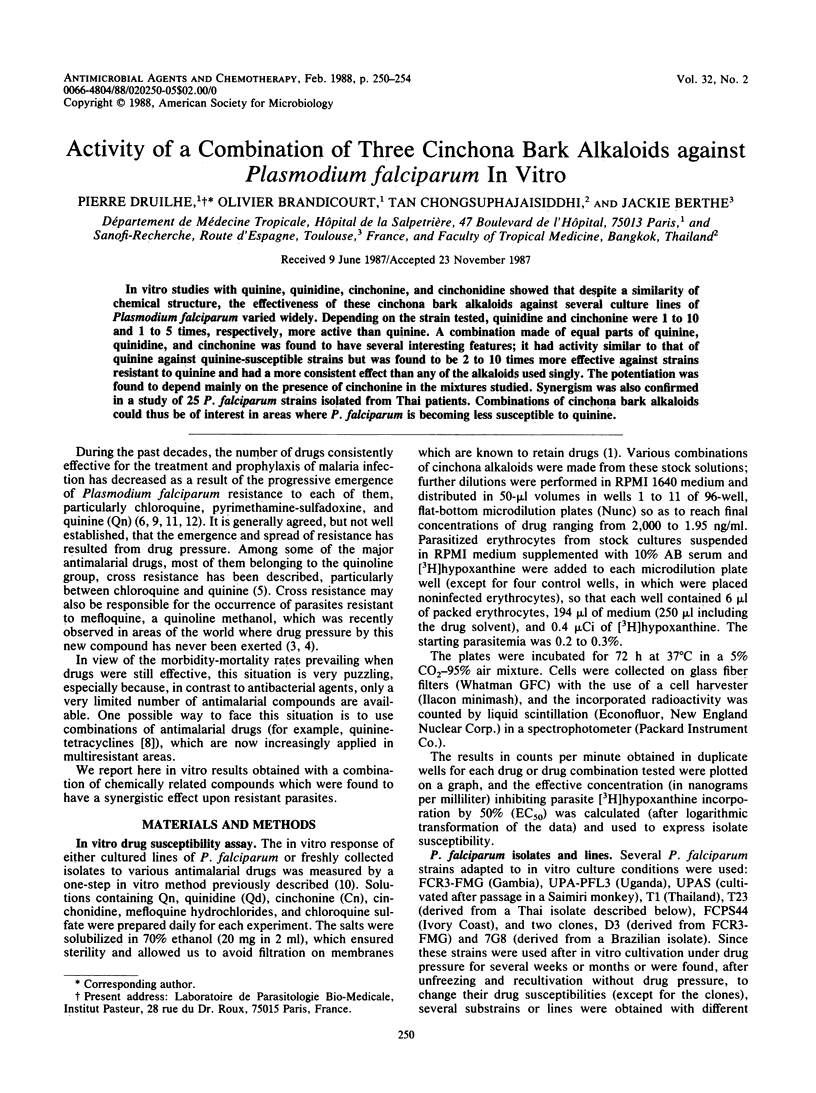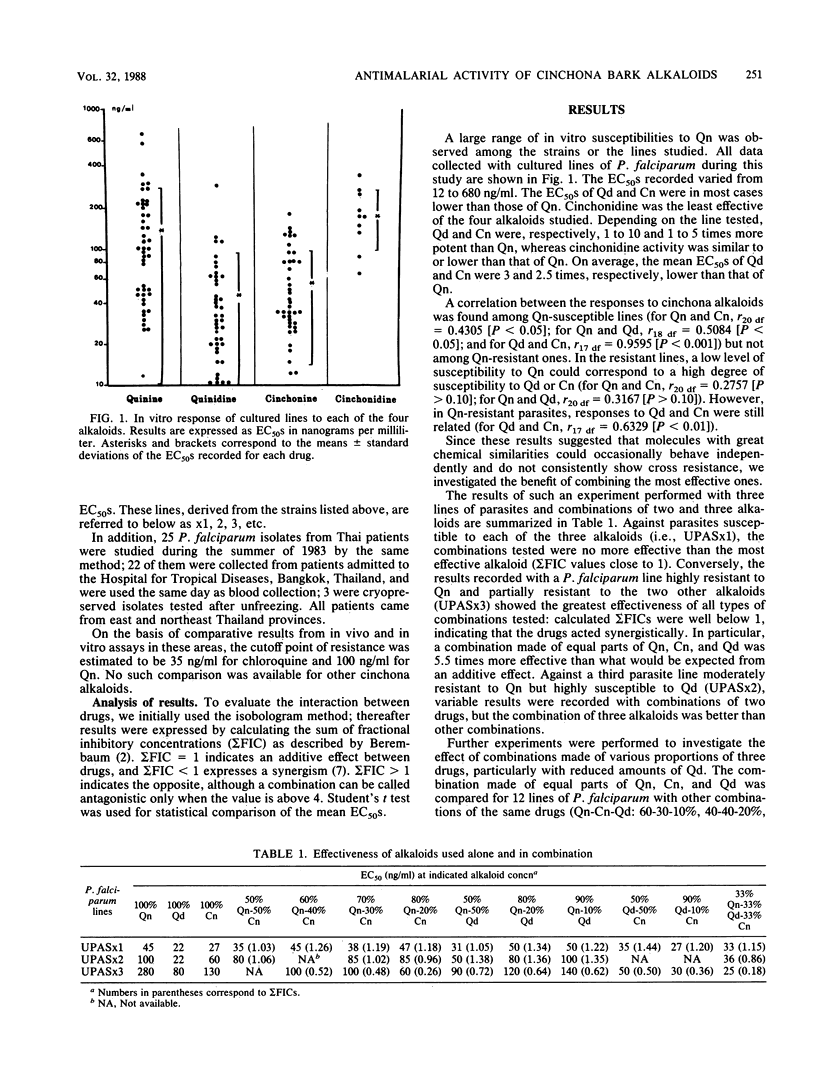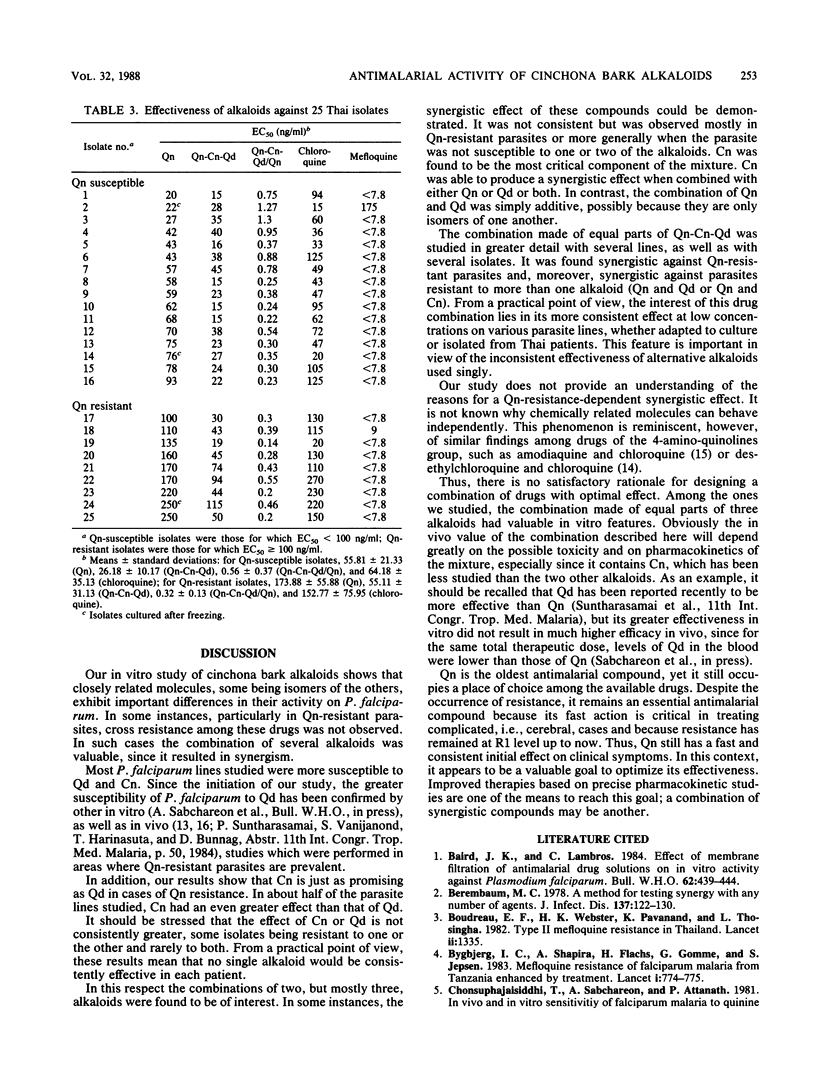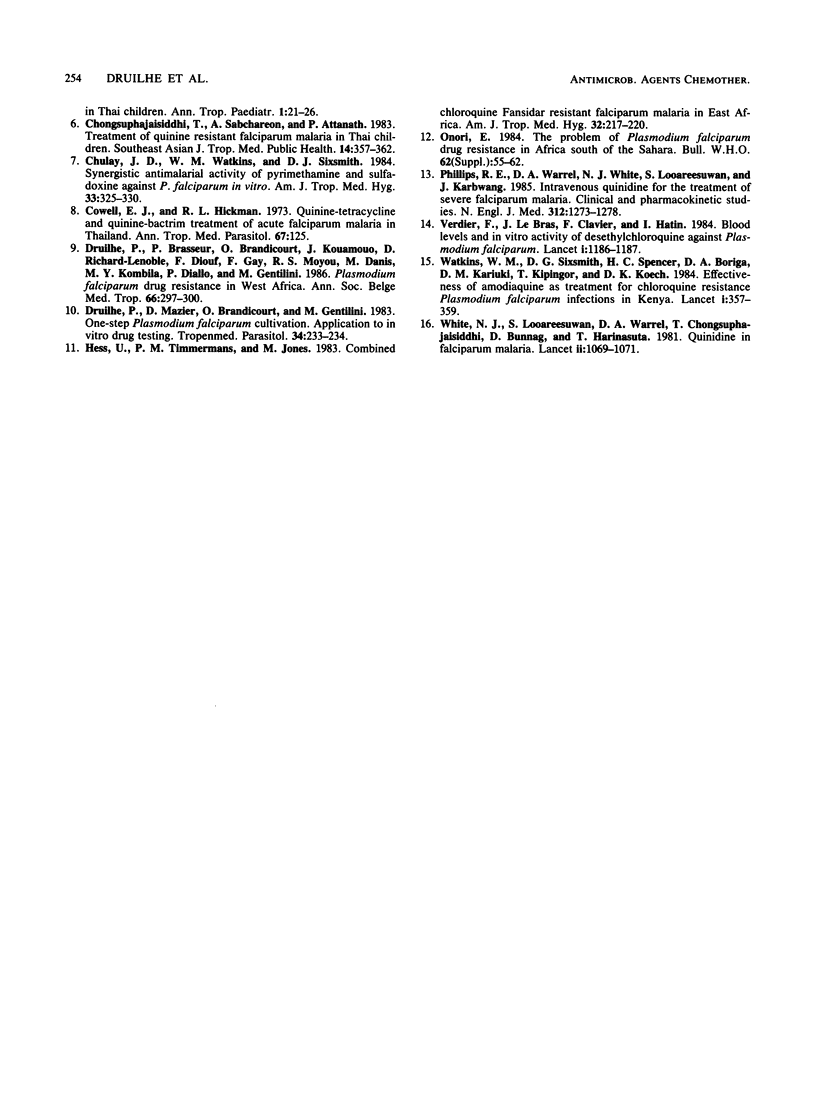Abstract
In vitro studies with quinine, quinidine, cinchonine, and cinchonidine showed that despite a similarity of chemical structure, the effectiveness of these cinchona bark alkaloids against several culture lines of Plasmodium falciparum varied widely. Depending on the strain tested, quinidine and cinchonine were 1 to 10 and 1 to 5 times, respectively, more active than quinine. A combination made of equal parts of quinine, quinidine, and cinchonine was found to have several interesting features; it had activity similar to that of quinine against quinine-susceptible strains but was found to be 2 to 10 times more effective against strains resistant to quinine and had a more consistent effect than any of the alkaloids used singly. The potentiation was found to depend mainly on the presence of cinchonine in the mixtures studied. Synergism was also confirmed in a study of 25 P. falciparum strains isolated from Thai patients. Combinations of cinchona bark alkaloids could thus be of interest in areas where P. falciparum is becoming less susceptible to quinine.
Full text
PDF




Selected References
These references are in PubMed. This may not be the complete list of references from this article.
- Baird J. K., Lambros C. Effect of membrane filtration of antimalarial drug solutions on in vitro activity against Plasmodium falciparum. Bull World Health Organ. 1984;62(3):439–444. [PMC free article] [PubMed] [Google Scholar]
- Berenbaum M. C. A method for testing for synergy with any number of agents. J Infect Dis. 1978 Feb;137(2):122–130. doi: 10.1093/infdis/137.2.122. [DOI] [PubMed] [Google Scholar]
- Boudreau E. F., Webster H. K., Pavanand K., Thosingha L. Type II mefloquine resistance in Thailand. Lancet. 1982 Dec 11;2(8311):1335–1335. doi: 10.1016/s0140-6736(82)91532-x. [DOI] [PubMed] [Google Scholar]
- Bygbjerg I. C., Schapira A., Flachs H., Gomme G., Jepsen S. Mefloquine resistance of falciparum malaria from Tanzania enhanced by treatment. Lancet. 1983 Apr 2;1(8327):774–775. doi: 10.1016/s0140-6736(83)92070-6. [DOI] [PubMed] [Google Scholar]
- Chongsuphajaisiddhi T., Sabchareon A., Attanath P. Treatment of quinine resistant falciparum malaria in Thai children. Southeast Asian J Trop Med Public Health. 1983 Sep;14(3):357–362. [PubMed] [Google Scholar]
- Chulay J. D., Watkins W. M., Sixsmith D. G. Synergistic antimalarial activity of pyrimethamine and sulfadoxine against Plasmodium falciparum in vitro. Am J Trop Med Hyg. 1984 May;33(3):325–330. doi: 10.4269/ajtmh.1984.33.325. [DOI] [PubMed] [Google Scholar]
- Colwell E. J., Hickman R. L., Kosakal S. Quinine-tetracycline and quinine-bactrim treatment of acute falciparum malaria in Thailand. Ann Trop Med Parasitol. 1973 Jun;67(2):125–132. doi: 10.1080/00034983.1973.11686870. [DOI] [PubMed] [Google Scholar]
- Druilhe P., Brasseur P., Brandicourt O., Kouamouo J., Richard-Lenoble D., Diouf F., Gay F., Moyou R. S., Danis M., Kombila M. Y. Plasmodium falciparum drug resistance in West Africa. Ann Soc Belg Med Trop. 1986;66(4):297–300. [PubMed] [Google Scholar]
- Druilhe P., Mazier D., Brandicourt O., Gentilini M. One-step Plasmodium falciparum cultivation--application to in-vitro drug testing. Tropenmed Parasitol. 1983 Dec;34(4):233–234. [PubMed] [Google Scholar]
- Hess U., Timmermans P. M., Jones M. Combined chloroquine/Fansidar-resistant falciparum malaria appears in East Africa. Am J Trop Med Hyg. 1983 Mar;32(2):217–220. doi: 10.4269/ajtmh.1983.32.217. [DOI] [PubMed] [Google Scholar]
- Onori E. The problem of Plasmodium falciparum drug resistance in Africa south of the Sahara. Bull World Health Organ. 1984;62 (Suppl):55–62. [PMC free article] [PubMed] [Google Scholar]
- Phillips R. E., Warrell D. A., White N. J., Looareesuwan S., Karbwang J. Intravenous quinidine for the treatment of severe falciparum malaria. Clinical and pharmacokinetic studies. N Engl J Med. 1985 May 16;312(20):1273–1278. doi: 10.1056/NEJM198505163122001. [DOI] [PubMed] [Google Scholar]
- Verdier F., Le Bras J., Clavier F., Hatin I. Blood levels and in vitro activity of desethylchloroquine against Plasmodium falciparum. Lancet. 1984 May 26;1(8387):1186–1187. doi: 10.1016/s0140-6736(84)91436-3. [DOI] [PubMed] [Google Scholar]
- Watkins W. M., Sixsmith D. G., Spencer H. C., Boriga D. A., Kariuki D. M., Kipingor T., Koech D. K. Effectiveness of amodiaquine as treatment for chloroquine-resistant Plasmodium falciparum infections in Kenya. Lancet. 1984 Feb 18;1(8373):357–359. doi: 10.1016/s0140-6736(84)90410-0. [DOI] [PubMed] [Google Scholar]
- White N. J., Looareesuwan S., Warrell D. A., Chongsuphajaisiddhi T., Bunnag D., Harinasuta T. Quinidine in falciparum malaria. Lancet. 1981 Nov 14;2(8255):1069–1071. doi: 10.1016/s0140-6736(81)91275-7. [DOI] [PubMed] [Google Scholar]


